Prior to 1969 in AMA competition, side-valve engines (like the Harley-Davidson KR) were allowed 750cc, and overhead-valve engines got just 500cc. When new rules for 1970 made it 750cc for everybody (to make a place in racing for the cool new Triumph Trident, BSA Rocket 3 and Honda CB750), few people realized what a can of worms had just been unleashed by the dogs of war, suddenly able to stand on their back legs and operate the can opener.
BSA and Triumph had special race versions of their new Triples for Daytona 1970, with BSA pulling Mike Hailwood out of retirement to ride one of them (along with David Aldana and Jim Rice). Triumph had Gary Nixon, Gene Romero and Paul Smart. Honda threw four of its new CB750s into the 1970 Daytona 200, and Dick Mann was there at the end of an attritious battle to take the win on one of them (after 13 years of trying). To celebrate, Honda promptly dropped right back out of roadracing. Mann won again in 1971 anyway, this time on a BSA. The British were still hanging in there.
But when 1972 came around, hard times for the British industry had caused it to greatly curtail its lavish racing investment and lay off much of its talent; the young Don Emde was forced to trade in his BSA for a new Yamaha 350 Twin and promptly won the 200 on it—the smallest engine ever to do so, and the first two-stroke.
Suzuki and Kawasaki had also picked up the plot by 1972 and showed up with seriously racerized versions of their GT750 and H2 streetbikes: TR750 and H2R. These 100-horsepower Triples were able to motor right on past 170 mph; unfortunately, lagging tire technology meant all that power didn’t really help them escape the much slower British machines, and other key components were also longevity-impaired. Art Baumann’s Suzuki’s magneto gave up the ghost nine laps in while leading. Yvon DuHamel’s Kawasaki packed it in not much later. Gary Nixon’s Kawi broke its gearbox. Bad luck? New Zealander Geoff Perry’s Suzuki broke its chain one lap from the end while leading the 200, handing the race to Don Emde’s little Yamaha. In 1973, Perry would again be leading the 200 only to have an ignition failure. Later that year, he was aboard an airliner that crashed into the Pacific.
By 1973, in an effort to slow the fastest bikes down and give their tires a break, the chicane was added at the end of the Daytona back straight—but the Kanji was already written on the wall. This one would be the last Daytona before Yamaha grafted two 350s together to produce the TZ700, before Goodyear and Dunlop filled in all the tread with rubber and produced the first racing slicks, and before death came for a couple of roadracing's rising stars; both 200-winner Jarno Saarinen and Cal Rayborn were killed in racing accidents the same year. At Daytona 1973, though, with a grid full of British Triples, Harley-Davidsons, a couple of Nortons and all the Japanese, it still looked like motorcycle racing might keep on being a wide-open game almost anybody could win, a sport only slightly removed from the beach where it had all begun just a generation or two before.
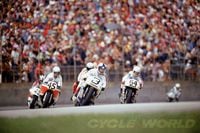
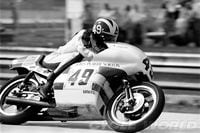
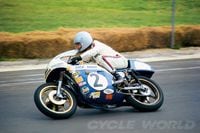
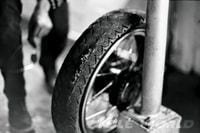
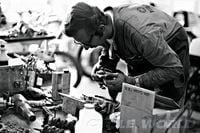
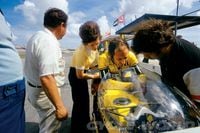
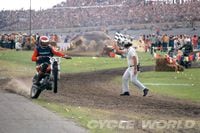
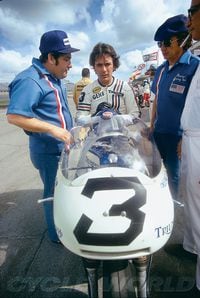
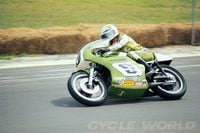
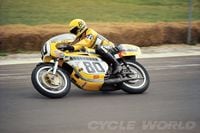
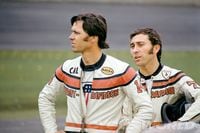
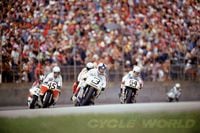
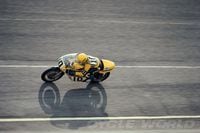
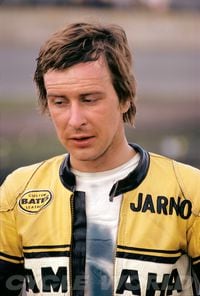
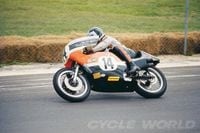
/cloudfront-us-east-1.images.arcpublishing.com/octane/R26K447HPJFXNL7HDNAIY4VOI4.jpg)
/cloudfront-us-east-1.images.arcpublishing.com/octane/U3S3JPJT5REW7NTPZMUP2FZY3A.jpg)
/cloudfront-us-east-1.images.arcpublishing.com/octane/WPQ2LXEKPVFZRF2CZLPSDOMVAI.jpg)
/cloudfront-us-east-1.images.arcpublishing.com/octane/BNSDRE4DCJE5ZPOLGPBZPOMZEI.jpg)
/cloudfront-us-east-1.images.arcpublishing.com/octane/GO6FSVIIKNBVPLSIS7IBWE7AEM.jpg)
/cloudfront-us-east-1.images.arcpublishing.com/octane/CS6TMZNTENGKFDW56HSE2HFZ2M.jpg)
/cloudfront-us-east-1.images.arcpublishing.com/octane/FUFID44YDBAM3EHF2AV5LDHLVE.jpg)
/cloudfront-us-east-1.images.arcpublishing.com/octane/QKEXZXUGVFATPE7RAT3HAHDQZ4.jpg)
/cloudfront-us-east-1.images.arcpublishing.com/octane/T7GEMBOUDBHX7EDP2PRQ2J2XME.jpg)
/cloudfront-us-east-1.images.arcpublishing.com/octane/U4CKRUKLKZD43FDSDLZHBL7YVA.jpg)
/cloudfront-us-east-1.images.arcpublishing.com/octane/OFSXJJ5PZFEZ5D5ZPMCFVHJUMA.jpg)
/cloudfront-us-east-1.images.arcpublishing.com/octane/N2JLNLG44VEKBMEPORRDTMX5A4.jpg)
/cloudfront-us-east-1.images.arcpublishing.com/octane/PYWEGG6FHJD6XLPKICS7XHMMZ4.jpg)
/cloudfront-us-east-1.images.arcpublishing.com/octane/XXFQQQ4AYJDCXDGVW3JTHAYONI.jpg)
/cloudfront-us-east-1.images.arcpublishing.com/octane/WMF36OICPZEJDPKABMHQVHXBZ4.jpg)
/cloudfront-us-east-1.images.arcpublishing.com/octane/3DJ46QYFAJA5RIJILQR2XIZXM4.jpg)
/cloudfront-us-east-1.images.arcpublishing.com/octane/4HYMMY6K4JHMNEQ56FXTGAHKG4.jpg)
/cloudfront-us-east-1.images.arcpublishing.com/octane/KUENZXA3RFBIHIDGHEEVH6YNYE.jpg)
/cloudfront-us-east-1.images.arcpublishing.com/octane/UW6THULV65E4TDI4DWLOMDR7LY.jpg)
/cloudfront-us-east-1.images.arcpublishing.com/octane/5S5CDZTZPJBHJBLHENVXEFYKG4.jpg)
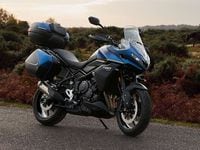
/cloudfront-us-east-1.images.arcpublishing.com/octane/RWF5RV5L55DMXMWZS2D3HZRJFA.jpg)
/cloudfront-us-east-1.images.arcpublishing.com/octane/JLDKEXSBAZGH7FAPRA5FMG4VII.jpg)
/cloudfront-us-east-1.images.arcpublishing.com/octane/GGOH2AQRSVHY5C5JLNEVYLB5SU.jpg)